MITSUBISHI L200 2017 Owner's Manual (in English)
Manufacturer: MITSUBISHI, Model Year: 2017, Model line: L200, Model: MITSUBISHI L200 2017Pages: 426, PDF Size: 14.12 MB
Page 321 of 426
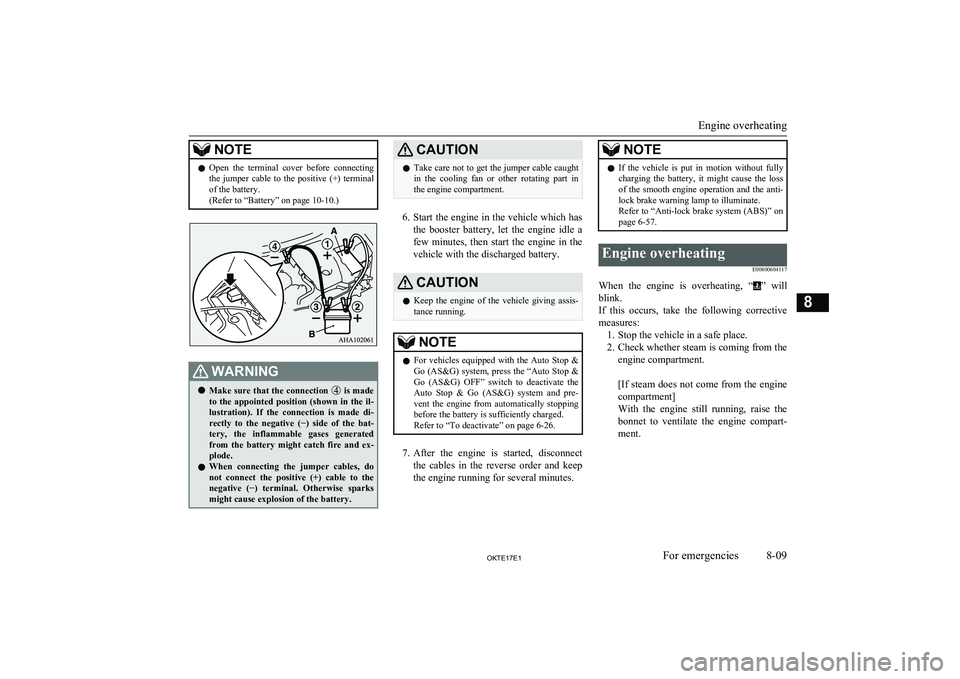
NOTElOpen the terminal cover before connecting
the jumper cable to the positive (+) terminal
of the battery.
(Refer to “Battery” on page 10-10.)WARNINGl Make sure that the connection is made
to the appointed position (shown in the il-
lustration). If the connection is made di-
rectly to the negative ( −) side of the bat-
tery, the inflammable gases generated
from the battery might catch fire and ex-
plode.
l When connecting the jumper cables, do
not connect the positive (+) cable to the
negative ( −) terminal. Otherwise sparks
might cause explosion of the battery.CAUTIONl Take care not to get the jumper cable caught
in the cooling fan or other rotating part in
the engine compartment.
6. Start the engine in the vehicle which has
the booster battery, let the engine idle a
few minutes, then start the engine in the vehicle with the discharged battery.
CAUTIONl Keep the engine of the vehicle giving assis-
tance running.NOTEl For vehicles equipped with the Auto Stop &
Go (AS&G) system, press the “Auto Stop &Go (AS&G) OFF” switch to deactivate theAuto Stop & Go (AS&G) system and pre- vent the engine from automatically stoppingbefore the battery is sufficiently charged.Refer to “To deactivate” on page 6-26.
7. After the engine is started, disconnect
the cables in the reverse order and keep the engine running for several minutes.
NOTEl If the vehicle is put in motion without fully
charging the battery, it might cause the loss
of the smooth engine operation and the anti- lock brake warning lamp to illuminate.
Refer to “Anti-lock brake system (ABS)” on
page 6-57.Engine overheating
E00800604117
When the engine is overheating, “” will
blink.
If this occurs, take the following corrective measures: 1. Stop the vehicle in a safe place.
2. Check whether steam is coming from the
engine compartment.
[If steam does not come from the engine
compartment]
With the engine still running, raise the
bonnet to ventilate the engine compart-
ment.
Engine overheating
8-09OKTE17E1For emergencies8
Page 322 of 426
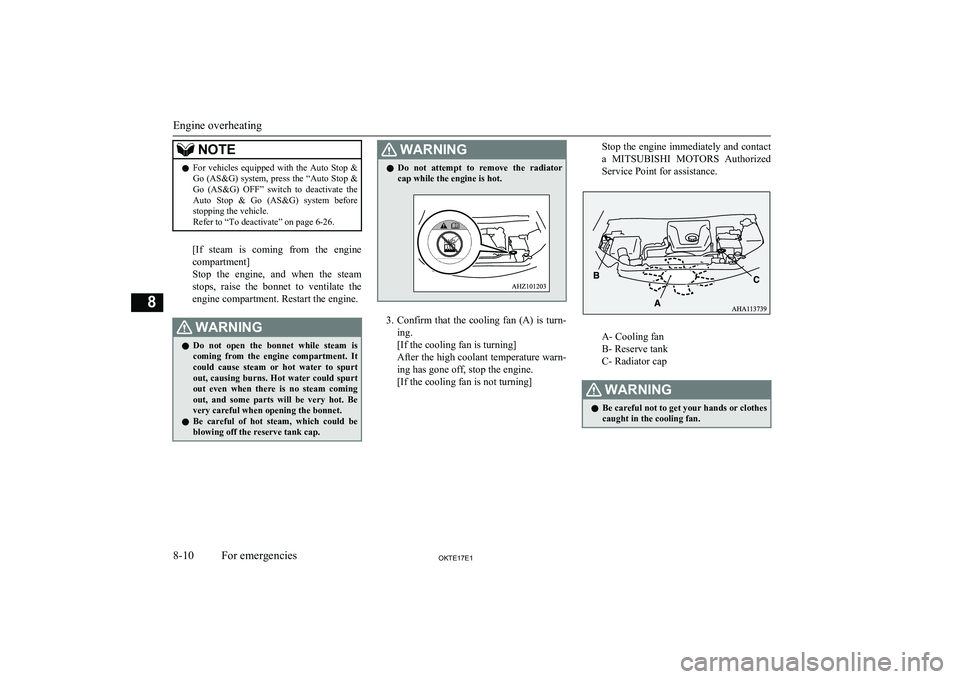
NOTElFor vehicles equipped with the Auto Stop &
Go (AS&G) system, press the “Auto Stop &Go (AS&G) OFF” switch to deactivate theAuto Stop & Go (AS&G) system before stopping the vehicle.
Refer to “To deactivate” on page 6-26.
[If steam is coming from the engine
compartment]
Stop the engine, and when the steam
stops, raise the bonnet to ventilate the engine compartment. Restart the engine.
WARNINGl Do not open the bonnet while steam is
coming from the engine compartment. It
could cause steam or hot water to spurt out, causing burns. Hot water could spurt
out even when there is no steam coming out, and some parts will be very hot. Be
very careful when opening the bonnet.
l Be careful of hot steam, which could be
blowing off the reserve tank cap.WARNINGl Do not attempt to remove the radiator
cap while the engine is hot.
3. Confirm that the cooling fan (A) is turn-
ing.
[If the cooling fan is turning]
After the high coolant temperature warn- ing has gone off, stop the engine.
[If the cooling fan is not turning]
Stop the engine immediately and contact
a MITSUBISHI MOTORS Authorized
Service Point for assistance.
A- Cooling fan
B- Reserve tank
C- Radiator cap
WARNINGl Be careful not to get your hands or clothes
caught in the cooling fan.
Engine overheating
8-10OKTE17E1For emergencies8
Page 323 of 426
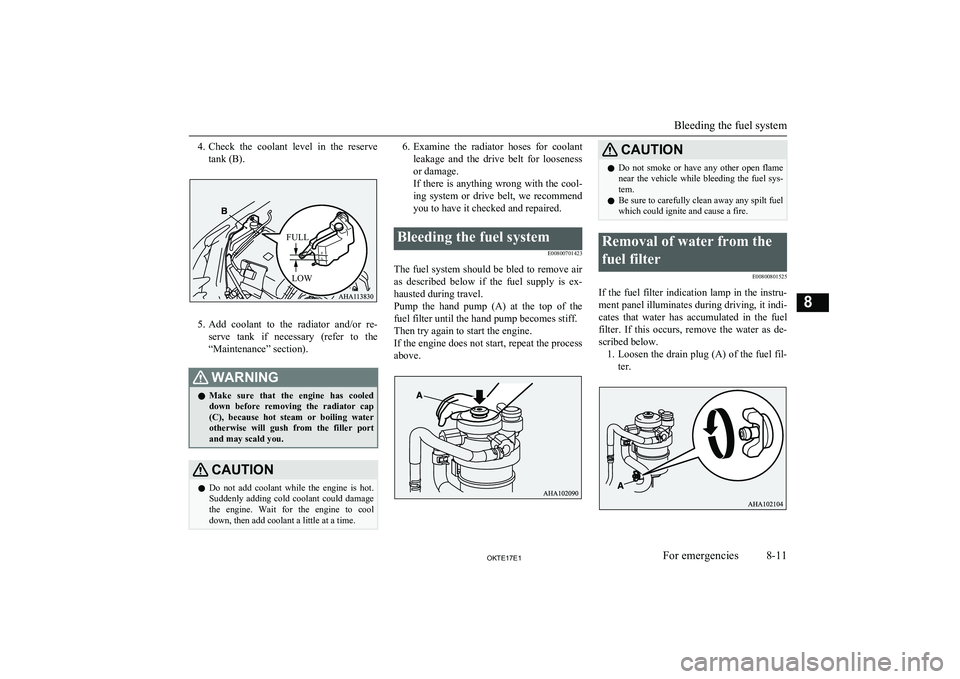
4.Check the coolant level in the reserve
tank (B).
5. Add coolant to the radiator and/or re-
serve tank if necessary (refer to the
“Maintenance” section).
WARNINGl Make sure that the engine has cooled
down before removing the radiator cap (C), because hot steam or boiling water
otherwise will gush from the filler port and may scald you.CAUTIONl Do not add coolant while the engine is hot.
Suddenly adding cold coolant could damage the engine. Wait for the engine to cool
down, then add coolant a little at a time.6. Examine the radiator hoses for coolant
leakage and the drive belt for looseness
or damage.
If there is anything wrong with the cool-
ing system or drive belt, we recommend
you to have it checked and repaired.Bleeding the fuel system
E00800701423
The fuel system should be bled to remove air
as described below if the fuel supply is ex- hausted during travel.
Pump the hand pump (A) at the top of the fuel filter until the hand pump becomes stiff.Then try again to start the engine.
If the engine does not start, repeat the process
above.
CAUTIONl Do not smoke or have any other open flame
near the vehicle while bleeding the fuel sys-
tem.
l Be sure to carefully clean away any spilt fuel
which could ignite and cause a fire.Removal of water from the
fuel filter E00800801525
If the fuel filter indication lamp in the instru-ment panel illuminates during driving, it indi-
cates that water has accumulated in the fuel filter. If this occurs, remove the water as de-
scribed below. 1. Loosen the drain plug (A) of the fuel fil-
ter.
Bleeding the fuel system
8-11OKTE17E1For emergencies8FULLLOW
Page 324 of 426

2.Operate the hand pump (B) slowly 6 or 7
times in order to force the water out
through the drain plug (A).
3. Tighten the drain plug (A) when water
no longer comes out.
4. Bleed the air in the fuel system. (Refer to “Bleeding the fuel system” onpage 8-11.)
5. Check to be sure that the fuel filter indi-
cation lamp illuminates when the igni- tion switch is turned to “ON” or the op-
eration mode is put in ON, and that it
goes off when the engine is started. If in
doubt, we recommend you to consult a specialist for necessary information.
CAUTIONl Do not smoke or have any other open flame
near the vehicle while bleeding the fuel sys-
tem.
l Be sure to carefully clean away any water
drained out because any fuel mixed with the water could ignite and cause a fire.Tools, jack and jack handle
E00800902695
Storage
The storage location of the tools, jack andjack handle should be remembered in case ofan emergency.
Single cab
A- Tool (wheel nut wrench)
B- Jack handle
C- Jack
A- Tools
B- Jack handle
C- Jack
Club cab
A- Tools
B- Jack
Tools, jack and jack handle
8-12OKTE17E1For emergencies8 Type 1 Type 2
Page 325 of 426
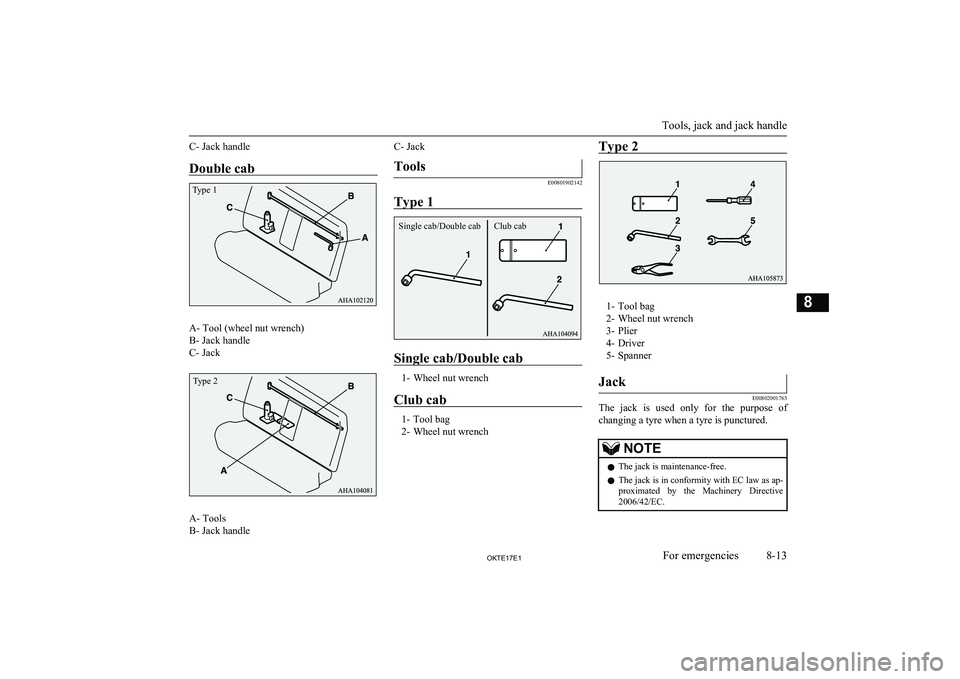
C- Jack handleDouble cab
A- Tool (wheel nut wrench)
B- Jack handle
C- Jack
A- Tools
B- Jack handle
C- JackTools
E00801902142
Type 1
Single cab/Double cab
1- Wheel nut wrench
Club cab
1- Tool bag
2- Wheel nut wrench
Type 2
1- Tool bag
2- Wheel nut wrench
3- Plier
4- Driver
5- Spanner
Jack
E00802001765
The jack is used only for the purpose of
changing a tyre when a tyre is punctured.
NOTEl The jack is maintenance-free.
l The jack is in conformity with EC law as ap-
proximated by the Machinery Directive
2006/42/EC.
Tools, jack and jack handle
8-13OKTE17E1For emergencies8Type 1 Type 2 Club cab
Single cab/Double cab
Page 326 of 426
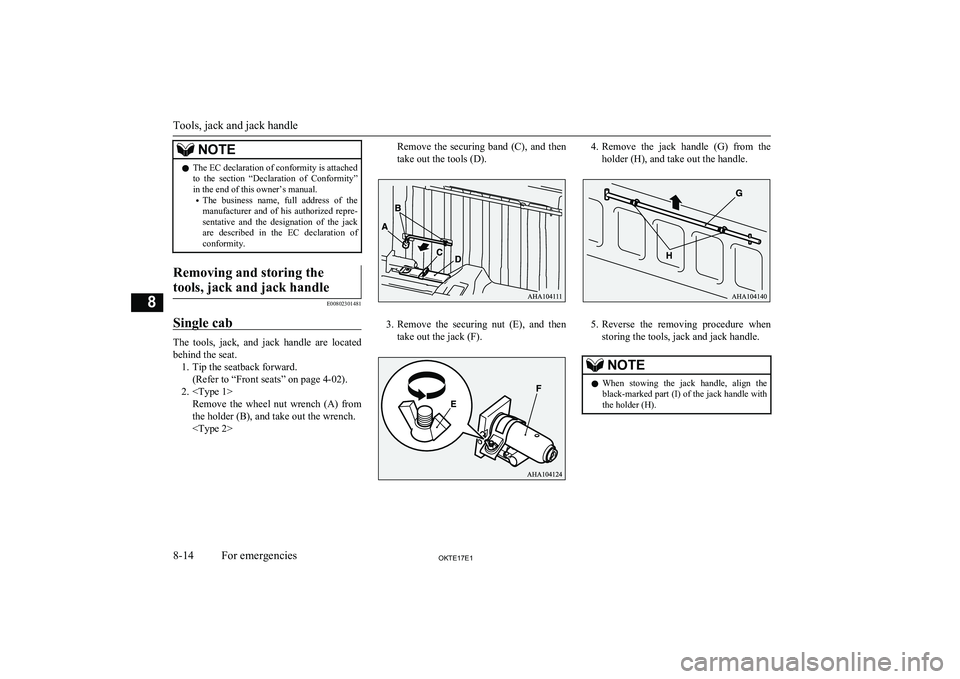
NOTElThe EC declaration of conformity is attached
to the section “Declaration of Conformity” in the end of this owner’s manual.
• The business name, full address of the
manufacturer and of his authorized repre-sentative and the designation of the jack
are described in the EC declaration of conformity.Removing and storing the
tools, jack and jack handle
E00802301481
Single cab
The tools, jack, and jack handle are located
behind the seat. 1. Tip the seatback forward. (Refer to “Front seats” on page 4-02).
2.
Remove the securing band (C), and then
take out the tools (D).
3. Remove the securing nut (E), and then
take out the jack (F).
4. Remove the jack handle (G) from the
holder (H), and take out the handle.
5. Reverse the removing procedure when
storing the tools, jack and jack handle.
NOTEl When stowing the jack handle, align the
black-marked part (I) of the jack handle with
the holder (H).
Tools, jack and jack handle
8-14OKTE17E1For emergencies8
Page 327 of 426
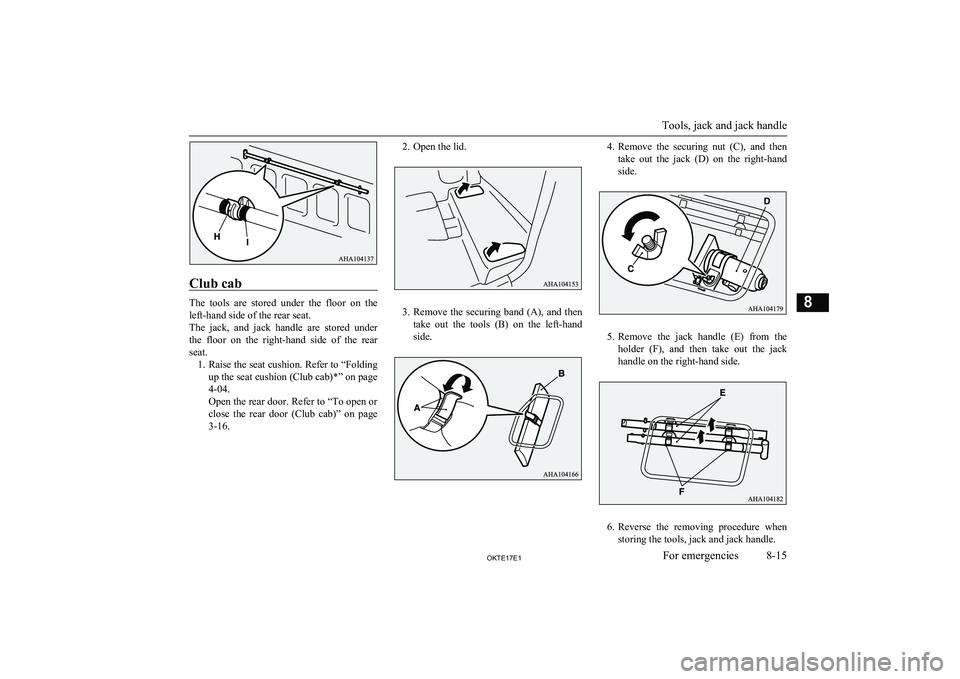
Club cab
The tools are stored under the floor on the
left-hand side of the rear seat.
The jack, and jack handle are stored under the floor on the right-hand side of the rear
seat. 1. Raise the seat cushion. Refer to “Folding
up the seat cushion (Club cab)*” on page
4-04.
Open the rear door. Refer to “To open or
close the rear door (Club cab)” on page
3-16.
2. Open the lid.
3. Remove the securing band (A), and then
take out the tools (B) on the left-hand side.
4. Remove the securing nut (C), and then
take out the jack (D) on the right-hand
side.
5. Remove the jack handle (E) from the
holder (F), and then take out the jack
handle on the right-hand side.
6. Reverse the removing procedure when
storing the tools, jack and jack handle.
Tools, jack and jack handle
8-15OKTE17E1For emergencies8
Page 328 of 426
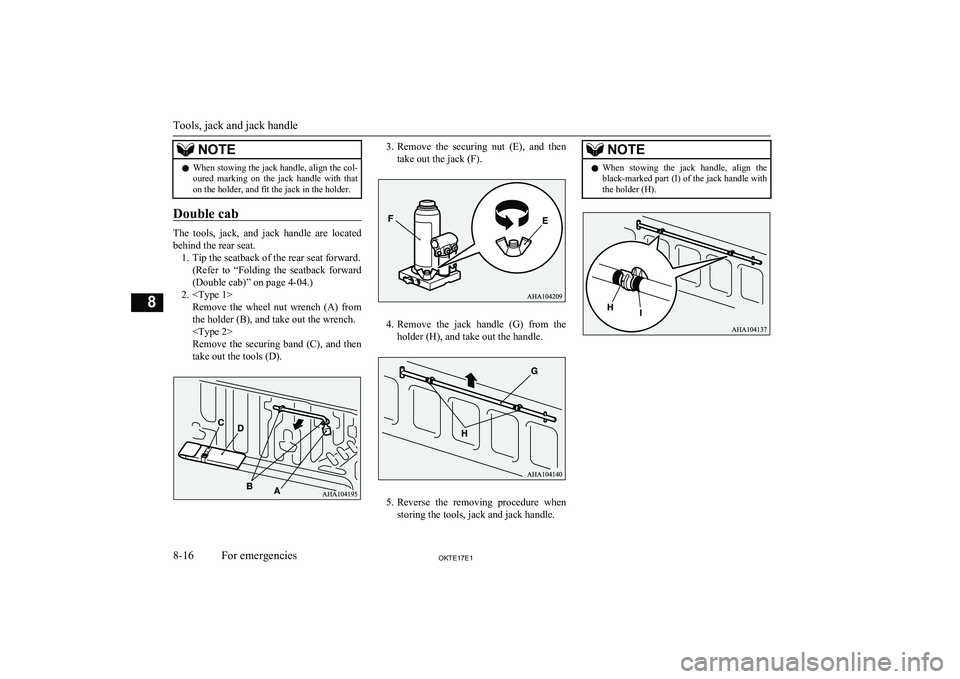
NOTElWhen stowing the jack handle, align the col-
oured marking on the jack handle with that
on the holder, and fit the jack in the holder.
Double cab
The tools, jack, and jack handle are located
behind the rear seat. 1. Tip the seatback of the rear seat forward. (Refer to “Folding the seatback forward
(Double cab)” on page 4-04.)
2.
Remove the securing band (C), and then
take out the tools (D).
3. Remove the securing nut (E), and then
take out the jack (F).
4. Remove the jack handle (G) from the
holder (H), and take out the handle.
5. Reverse the removing procedure when
storing the tools, jack and jack handle.
NOTEl When stowing the jack handle, align the
black-marked part (I) of the jack handle with
the holder (H).
Tools, jack and jack handle
8-16OKTE17E1For emergencies8
Page 329 of 426
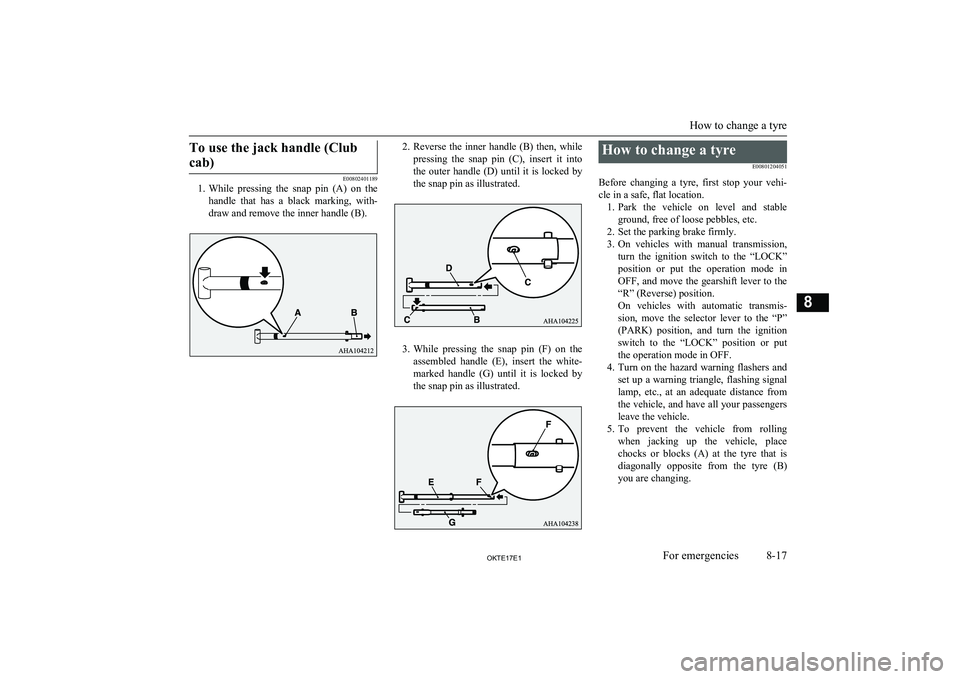
To use the jack handle (Clubcab)
E00802401189
1. While pressing the snap pin (A) on the
handle that has a black marking, with-draw and remove the inner handle (B).
2. Reverse the inner handle (B) then, while
pressing the snap pin (C), insert it into
the outer handle (D) until it is locked by the snap pin as illustrated.
3. While pressing the snap pin (F) on the
assembled handle (E), insert the white-
marked handle (G) until it is locked by the snap pin as illustrated.
How to change a tyre
E00801204051
Before changing a tyre, first stop your vehi- cle in a safe, flat location. 1. Park the vehicle on level and stable
ground, free of loose pebbles, etc.
2. Set the parking brake firmly.
3. On vehicles with manual transmission,
turn the ignition switch to the “LOCK”
position or put the operation mode in
OFF, and move the gearshift lever to the
“R” (Reverse) position.
On vehicles with automatic transmis- sion, move the selector lever to the “P” (PARK) position, and turn the ignitionswitch to the “LOCK” position or put
the operation mode in OFF.
4. Turn on the hazard warning flashers and
set up a warning triangle, flashing signal
lamp, etc., at an adequate distance from
the vehicle, and have all your passengers
leave the vehicle.
5. To prevent the vehicle from rolling
when jacking up the vehicle, placechocks or blocks (A) at the tyre that is
diagonally opposite from the tyre (B)
you are changing.
How to change a tyre
8-17OKTE17E1For emergencies8
Page 330 of 426
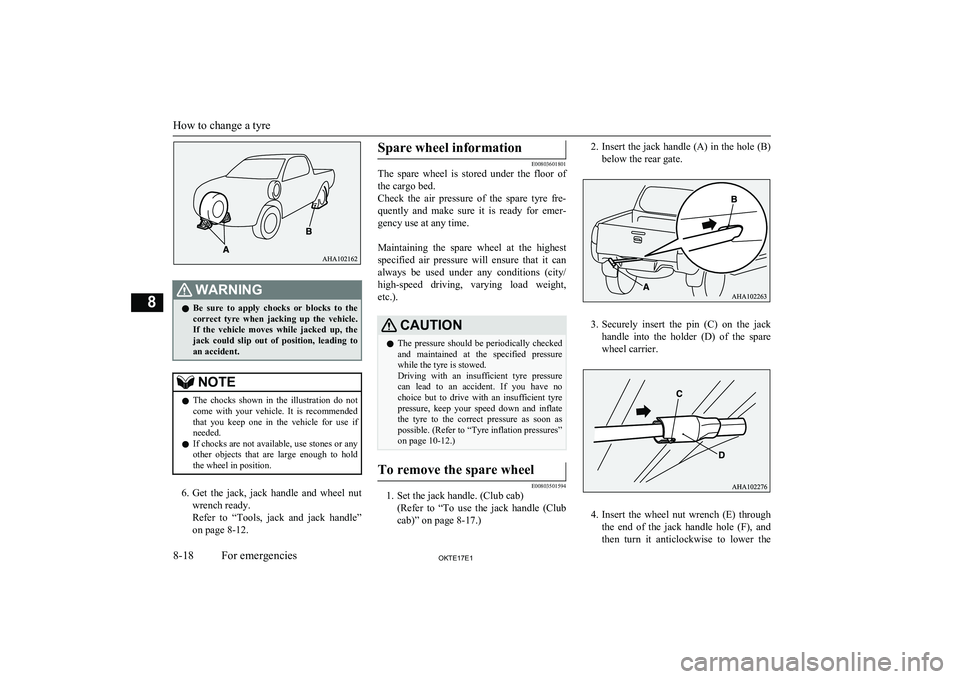
WARNINGlBe sure to apply chocks or blocks to the
correct tyre when jacking up the vehicle.If the vehicle moves while jacked up, the
jack could slip out of position, leading to
an accident.NOTEl The chocks shown in the illustration do not
come with your vehicle. It is recommended
that you keep one in the vehicle for use if needed.
l If chocks are not available, use stones or any
other objects that are large enough to hold the wheel in position.
6. Get the jack, jack handle and wheel nut
wrench ready.
Refer to “Tools, jack and jack handle” on page 8-12.
Spare wheel information
E00803601801
The spare wheel is stored under the floor of
the cargo bed.
Check the air pressure of the spare tyre fre-
quently and make sure it is ready for emer- gency use at any time.
Maintaining the spare wheel at the highest
specified air pressure will ensure that it can always be used under any conditions (city/ high-speed driving, varying load weight,
etc.).
CAUTIONl The pressure should be periodically checked
and maintained at the specified pressure while the tyre is stowed.
Driving with an insufficient tyre pressure
can lead to an accident. If you have no choice but to drive with an insufficient tyre
pressure, keep your speed down and inflate the tyre to the correct pressure as soon as
possible. (Refer to “Tyre inflation pressures”
on page 10-12.)To remove the spare wheel
E00803501594
1. Set the jack handle. (Club cab)
(Refer to “To use the jack handle (Clubcab)” on page 8-17.)
2. Insert the jack handle (A) in the hole (B)
below the rear gate.
3. Securely insert the pin (C) on the jack
handle into the holder (D) of the spare
wheel carrier.
4. Insert the wheel nut wrench (E) through
the end of the jack handle hole (F), and
then turn it anticlockwise to lower the
How to change a tyre
8-18OKTE17E1For emergencies8